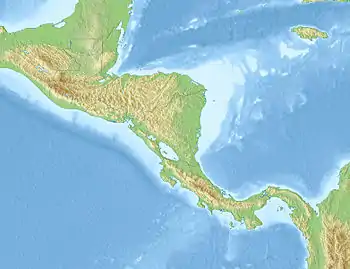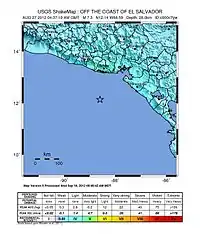 | |
| UTC time | 2012-08-27 04:37:19 |
|---|---|
| ISC event | 601626911 |
| USGS-ANSS | ComCat |
| Local date | 26 August 2012 |
| Local time | 22:37 CST |
| Magnitude | 7.3 Mw [1] |
| Depth | 16.0 km (10 mi) [1] |
| Epicenter | 12°08′20″N 88°35′24″W / 12.139°N 88.590°W |
| Type | Thrust |
| Areas affected | El Salvador and Nicaragua |
| Max. intensity | II (Weak) [2] |
| Tsunami | 6.3 m (21 ft) [3] |
| Foreshocks | Yes |
| Aftershocks | Yes |
| Casualties | >40 injured |
An earthquake occurred on 26 August 2012 at 22:37 local time (Central Standard Time). The earthquake located off the coast of El Salvador measured 7.3 on the moment magnitude scale (Mw) and had a focal depth of 16.0 kilometres (10 mi).[1] No deaths were reported, however more than 40 people were injured when they were caught in a tsunami generated by the earthquake. Waves from the tsunami were unusually large for an earthquake of this size. The large waves were attributed to the earthquake's unique rupture characteristic.[4] In addition to the absence of fatalities, damage caused by the earthquake and tsunami was minimal as a result of the sparse population around the affected region and the slow rupture characteristic of the event.
Tectonic setting
Off the west coast of Central America, including El Salvador and Nicaragua, lies a convergent plate margin where two tectonic plates collide. The Cocos Plate, made of oceanic crust moves northeast, towards the Caribbean Plate where Central America sits on continental crust. The two lithospheres meet at the Middle America Trench, where the Cocos Plate being denser, subducts under the Caribbean Plate. GPS data collected over a period of two decades showed that the Cocos Plate is moving towards Central America at a rate of 8.23 ± 0.22 cm (3.240 ± 0.087 in)/year.[5] Seismic activity on the subduction zone has been responsible for large and tsunamigenic earthquakes caused by the rupture of the fault. Many large earthquakes including the Mw 7.6 1992 Nicaragua earthquake are associated with rupture on the subduction zone.[6]
Earthquake

The earthquake was associated with rupture on the subduction zone. It produced slip of up to 1.2 m (4 ft) on the first 4–20 km (2.5–12.4 mi) section of the megathrust along a 50 km (31 mi) length.[7] The source region of this earthquake was the shallow section of the subduction zone. The rupture propagated with an estimated velocity of 2 km (1.2 mi)/s, which is unusually slow for most subduction zone earthquakes. In addition, the release of seismic energy occurred in long periods—a characteristic of tsunami earthquakes.[7] The rate at which seismic energy was released in this event was at least 25 times smaller than earthquakes of similar magnitudes. However, with a rupture prolongation of 59 seconds, it was three times longer than usual. The rupture process of this event is reminiscent of the 1992 tsunami earthquake.[8]
Given the earthquake released long-period seismic energy, shaking was relatively mild and in many parts of the coast, undetected by people present at the time. According to many residents living in San Salvador, the earthquake was not perceived at all, or that shaking was very weak, only reaching level II on the Mercalli intensity scale.[9][10] Even at the coast, light shaking was reported by many residents for as long as three minutes.[11] No damage was reported due to weak shaking.[9]
Tsunami
In just ten minutes of the earthquake, the Pacific Tsunami Warning Center (PTWC) characterized the event as being a "slow earthquake". The PTWC issued the first bulletin material, a tsunami advisory, eight minutes after the event to the coasts of Central America. After receiving strong evidence that the event was a tsunami earthquake, they raised the advisory to a tsunami warning.[11]
The slow rupture characteristic of the El Salvador earthquake meant that it was an efficient tsunami generator. Field surveys conducted in September 2012 along the coast of El Salvador and Nicaragua showed that the tsunami had a maximum height of over 6 metres (20 ft) along a 25 km stretch of coastline on the San Juan del Gozo Peninsula of Jiquilisco Bay, Usulután.[8]
Many workers involved in conservation efforts were collecting sea turtle eggs along beaches at night when the tsunami struck.[12] The waves engulfed many workers and dragged them at least 90 metres (295 ft) inland, with some left hanging on trees a few meters above the ground. A ramada purposed for a hatchery located 70 metres (230 ft) from the shore had its walls torn off and posts knocked down (but not pulled from the sand) by the waves.[7] More than 40 people were injured, with at least three being serious and needing medical treatment.
An eyewitness at the beach during the time of the event recalled seeing three waves although researchers speculate that there was a confusion in distinguishing waves of a tsunami and those caused by wind.[11] The same eyewitness said the waves penetrated at least 340 metres (1,115 ft) inland, where the flow depth was less than a meter high.[11]
Another survivor said three waves were seen, the first of which carried him hundreds of meters inland.[11] After the tsunami, a local civil protection coordinator (who felt the earthquake for 20–30 seconds) arrived at the beach and described hearing gurgling noises, caused by water draining into sand. It took roughly 20 minutes for the tsunami water to retreat and completely drain.[11]
Surveyors did not report same effects from the tsunami at Playa Costa del Sol, a beach resort ~10 km west of the peninsula. This was said at La Puntilla where many seafront houses and businesses are located. No distinguishable impacts were made as a result of the tsunami. In addition, many eyewitnesses from El Salvador were interviewed and they did not observe any tsunami activity.[8] In Playa El Espino and Playa El Cuco, hotel workers and boat captains did not report any anomalies along the coast such as boats being moved significantly.[8] A resident in El Retiro saw two people and a horse dragged down a nearby beach by the wave. Further surveys later showed evidence of tsunami inundation and overwash.[11]
In Nicaragua, the tsunami, with an estimated height of 0.5 metres (2 ft) or more caused moderate inundations in some coastal settlements.[8]
Other events
Just nine days after the earthquake, a magnitude 7.6 earthquake struck the Nicoya Peninsula in Costa Rica, killing two and injuring at least 20.[13] This earthquake was located 450 km southeast of the August 27 earthquake, on the same subduction zone. It was preceded by a sequence of foreshocks that began after the August 27 event. Further research suggest the former event triggered an uptick in seismic activity on the Nicoya Peninsula section of the megathrust.[14]
In November, the magnitude 7.4 Champerico earthquake off the west coast of Guatemala killed at least 48 people, left 100 missing and caused 155 injuries.[15] The earthquake was considered typical for most similar-sized subduction earthquakes, only rupturing the fault interface at 15–35 km depth. It did not share the slow rupture characteristic like that seen in the August 27 event.[16]
See also
References
- 1 2 3 ISC-OB Event 601626911 [IRIS].
- ↑ "M 7.3 - off the coast of El Salvador". earthquake.usgs.gov. USGS. Retrieved 21 April 2021.
- ↑ "Tsunami Event Information". ngdc.noaa.gov. NCEI. Retrieved 21 April 2021.
- ↑ José A. Álvarez-Gómez, Alejandra Staller Vázquez, José J. Martínez-Díaz, Carolina Canora, Jorge Alonso-Henar, Juan M. Insua-Arévalo & Marta Béjar-Pizarro (1 August 2019). "Push-pull driving of the Central America Forearc in the context of the Cocos-Caribbean-North America triple junction". Scientific Reports. 9 (11164): 11164. Bibcode:2019NatSR...911164A. doi:10.1038/s41598-019-47617-3. PMC 6671955. PMID 31371752.
{{cite journal}}: CS1 maint: multiple names: authors list (link) - ↑ Zamora, N., Babeyko, A.Y. (2016). "Tsunami potential from local seismic sources along the southern Middle America Trench" (PDF). Natural Hazards. 80 (2): 901–934. Bibcode:2016NatHa..80..901Z. doi:10.1007/s11069-015-2004-3. S2CID 130969961. Retrieved 21 April 2021.
{{cite journal}}: CS1 maint: multiple names: authors list (link) - ↑ Satake, Kenji (15 November 1994). "Mechanism of the 1992 Nicaragua Tsunami Earthquake". Geophysical Research Letters. 21 (23): 2519–2522. Bibcode:1994GeoRL..21.2519S. doi:10.1029/94GL02338. Retrieved 21 April 2021.
- 1 2 3 Ye, Lingling; Lay, Thorne; Kanamori, Hiroo (2013). "Large earthquake rupture process variations on the Middle America megathrust" (PDF). Earth and Planetary Science Letters. 381: 147–155. Bibcode:2013E&PSL.381..147Y. doi:10.1016/j.epsl.2013.08.042. Retrieved 21 April 2021.
{{cite journal}}: CS1 maint: multiple names: authors list (link) - 1 2 3 4 5 Borrero, J.C., Kalligeris, N., Lynett, P.J. (2014). "Observations and Modeling of the August 27, 2012 Earthquake and Tsunami affecting El Salvador and Nicaragua" (PDF). Pure and Applied Geophysics. 171 (12): 3421–3435. Bibcode:2014PApGe.171.3421B. doi:10.1007/s00024-014-0782-2. S2CID 1554690. Retrieved 21 April 2021.
{{cite journal}}: CS1 maint: multiple names: authors list (link) - 1 2 "A strong 7.4 magnitude earthquake shakes the coast of El Salvador" (in Spanish). elmundo.es. 27 August 2012. Retrieved 21 April 2021.
- ↑ Juan Andrés Muñoz (27 August 2012). "A 7.4 magnitude earthquake shakes El Salvador; tsunami warning is canceled" (in Spanish). CNN Español. Retrieved 21 April 2021.
- 1 2 3 4 5 6 7 Francisco Gavidia-Medina (2015). "Field survey report of tsunami effects caused by the August 2012 offshore El Salvador earthquake" (PDF). Science of Tsunami Hazards. 34 (4): 231–255. Retrieved 22 April 2021.
- ↑ DPA (11 September 2012). "Experts confirm that there was a tsunami in El Salvador after the August earthquake" (in Spanish). San Salvador, El Salvador. Emol. Retrieved 21 April 2021.
- ↑ "M 7.6 - Costa Rica". earthquake.usgs.gov. USGS. Retrieved 21 April 2021.
- ↑ Jacob I. Walter, Xiaofeng Meng, Zhigang Peng, Susan Y. Schwartz, Andrew V. Newman, Marino Protti (2015). "Far-field triggering of foreshocks near the nucleation zone of the 5 September 2012 (MW 7.6) Nicoya Peninsula, Costa Rica earthquake". Earth and Planetary Science Letters. 431: 75–86. Bibcode:2015E&PSL.431...75W. doi:10.1016/j.epsl.2015.09.017. ISSN 0012-821X.
{{cite journal}}: CS1 maint: multiple names: authors list (link) - ↑ "M 7.4 - offshore Guatemala". earthquake.usgs.gov. USGS. Retrieved 21 April 2021.
- ↑ Andria P. Ellis, Charles DeMets, Pierre Briole, Enrique Molina, Omar Flores, Jeffrey Rivera, Cécile Lasserre, Hélène Lyon-Caen, Neal Lord (2015). "Geodetic slip solutions for the Mw = 7.4 Champerico (Guatemala) earthquake of 2012 November 7 and its postseismic deformation". Geophysical Journal International. 201 (2): 856–868. doi:10.1093/gji/ggu484.
{{cite journal}}: CS1 maint: multiple names: authors list (link)
External links
- El Salvador Tsunami, August 27, 2012 Main Event Page (NOAA)
- El Salvador Tsunami, August 27, 2012 Local Impacts (NOAA)
- The International Seismological Centre has a bibliography and/or authoritative data for this event.